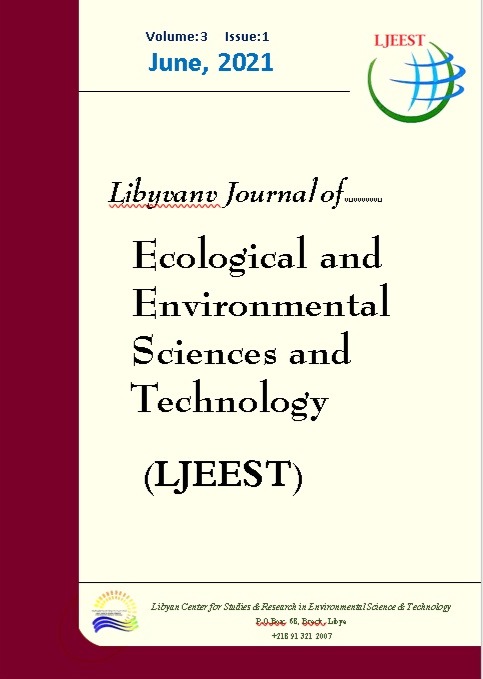Introductory Survey of the Moths Species Under Grassland Created in Alghyran Park, Janzour Libya
DOI:
https://doi.org/10.63359/wdg1c358Keywords:
Survey, moths, species, grassland,, ALGhyranAbstract
A preliminary study of the moths species in AL Ghyran park, Janzour city which located in (the west coast of Libya) this study was conducted from June 2020 to September 2020 in grassland created Habitats. A total of 7 species (Heliothis peltigera, Tetracis cachexiata, Sesamia nonagrioides, Pyrausta despicata, Agriphila inquinatella, Cornifrons ulceratalis and Acronicta aceris) were recorded belonging to 3 families, including to (Noctuidae, Geometridae and Crambidae). there three very common species were recorded (Pyrausta despicata, Heliothis peltigera and Sesamia nonagrioides). nonetheless, there was one species seen two time on restore grassland (Tetracis cachexiata).
References
Ackery, P. R., Smith, C., & Vane-Wright, R. (1995). Carcasson's african butterflies: An annotated catalogue of the papilionoidea and hesperioidea of the afrotropical region CSIRO PUBLISHING.
Andren, H., 1994. Effects of habitat fragmentation on birds and mammals in landscapes with different proportions of suitable habitat: a review. Oikos, pp.355-366.
Atauri, J. A., & de Lucio, J. V. (2001). The role of landscape structure in species richness distribution of birds, amphibians, reptiles and lepidopterans in mediterranean landscapes. Landscape Ecology, 16(2), 147-159.
Bell, S. S., McCoy, E. D., & Mushinsky, H. R. (2012). Habitat structure: The physical arrangement of objects in space Springer Science & Business Media.
Bergman, K., & Landin, J. (2002). Population structure and movements of a threatened butterfly (lopinga achine) in a fragmented landscape in sweden. Biological Conservation, 108(3), 361-369.
Brown, K. S. (1997). Diversity, disturbance, and sustainable use of neotropical forests: Insects as indicators for conservation monitoring. Journal of Insect Conservation, 1(1), 25-42.
Cranston, P. J. G. (2010). The insects: An outline of entomology/Penny J. gullan, peter S. cranston.
Fox, R., Parsons, M., Chapman, J., Woiwod, I., Warren, M., & Brooks, D. (2013). The state of Britain’s larger moths 2013. Butterfly Conservation and Rothamsted Research, Wareham, Dorset, UK,
Gadhikar, Y., Sambath, S., & Yattoo, I. (2015). A preliminary report on the moths (insecta: Lepidoptera: Heterocera) fauna from amravati, maharashtra. International Journal of Science and Research, 4(7), 883-887.
Kehimkar, I. D. (2008). Book of indian butterflies Oxford University Press.
Kitching, R., Orr, A., Thalib, L., Mitchell, H., Hopkins, M. S., & Graham, A. W. (2000). Moth assemblages as indicators of environmental quality in remnants of upland australian rain forest. Journal of Applied Ecology, 37(2), 284-297.
Kunte, K. (2000). India, a lifescape: Butterflies of peninsular india Universities Press.
Larsen, T. H., Williams, N. M., & Kremen, C. (2005). Extinction order and altered community structure rapidly disrupt ecosystem functioning. Ecology Letters, 8(5), 538-547.
Muirhead-Thomson, R. (1991). Plant pest responses to visual and olfactory ‘sticky’traps. Trap Responses of Flying Insects.Academic, CA, , 180-196.
New, T. (2004). Moths (insecta: Lepidoptera) and conservation: Background and perspective. Journal of Insect Conservation, 8(2-3), 79-94.
Resh, V. H., & Cardé, R. T. (2009). Encyclopedia of insects ,Academic press. 2nd Edition, Academic Press, Elsevier Science Publisher, London, Oxford, Boston, New York and San Diego, 953-957
Solis, M. A., & Pogue, M. G. (1999). Lepidopteran biodiversity: Patterns and estimators. American Entomologist, 45(4), 206-212.
Tews, J., Brose, U., Grimm, V., Tielbörger, K., Wichmann, M. C., Schwager, M., & Jeltsch, F. (2004). Animal species diversity driven by habitat heterogeneity/diversity: The importance of keystone structures. Journal of Biogeography, 31(1), 79-92.
Van Nieukerken, E. J., Kaila, L., Kitching, I. J., Kristensen, N. P., Lees, D. C., Minet, J., . . . Simonsen, T. J. (2011). Order lepidoptera linnaeus, 1758. in: Zhang, Z.-Q.(ed.) animal biodiversity: An outline of higher-level classification and survey of taxonomic richness. Zootaxa, 3148(1), 212-221.
Vaughan, N., Jones, G., & Harris, S. (1997). Habitat use by bats (chiroptera) assessed by means of a broad-band acoustic method. Journal of Applied Ecology, , 716-730.
Wickramasinghe, L. P., Harris, S., Jones, G., & Vaughan Jennings, N. (2004). Abundance and species richness of nocturnal insects on organic and conventional farms: Effects of agricultural intensification on bat foraging. Conservation Biology, 18(5), 1283-1292.
Wilson, R.J. P. J. Gullan and P. S. Cranston: The insects: an outline of entomology (4th edition). J Insect Conserv 14, 745–746 (2010). https://doi.org/10.1007/s10841-010-9351-x
Downloads
Published
Issue
Section
License
Copyright (c) 2025 Libyan Journal of Ecological & Environmental Sciences and Technology

This work is licensed under a Creative Commons Attribution-NonCommercial 4.0 International License.














